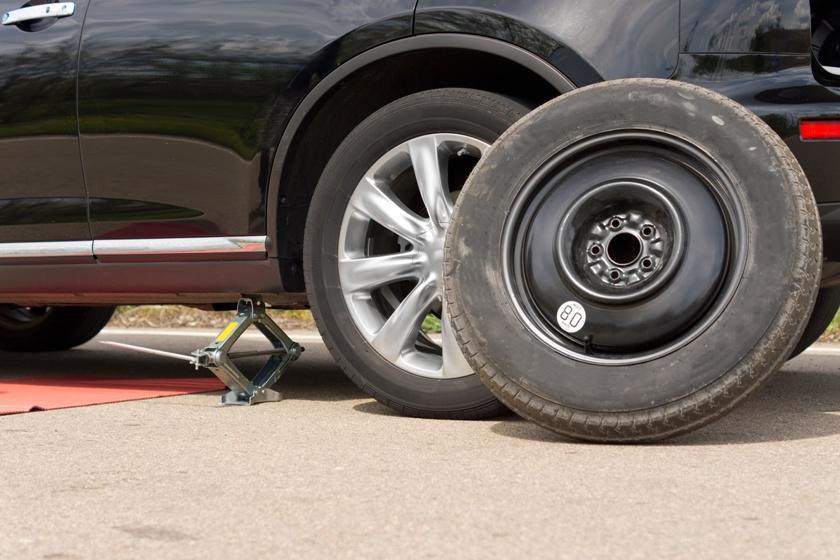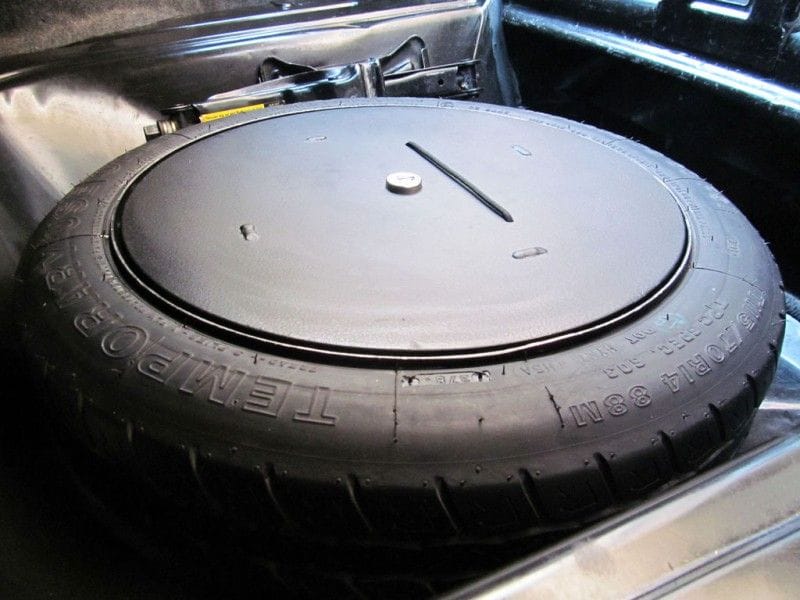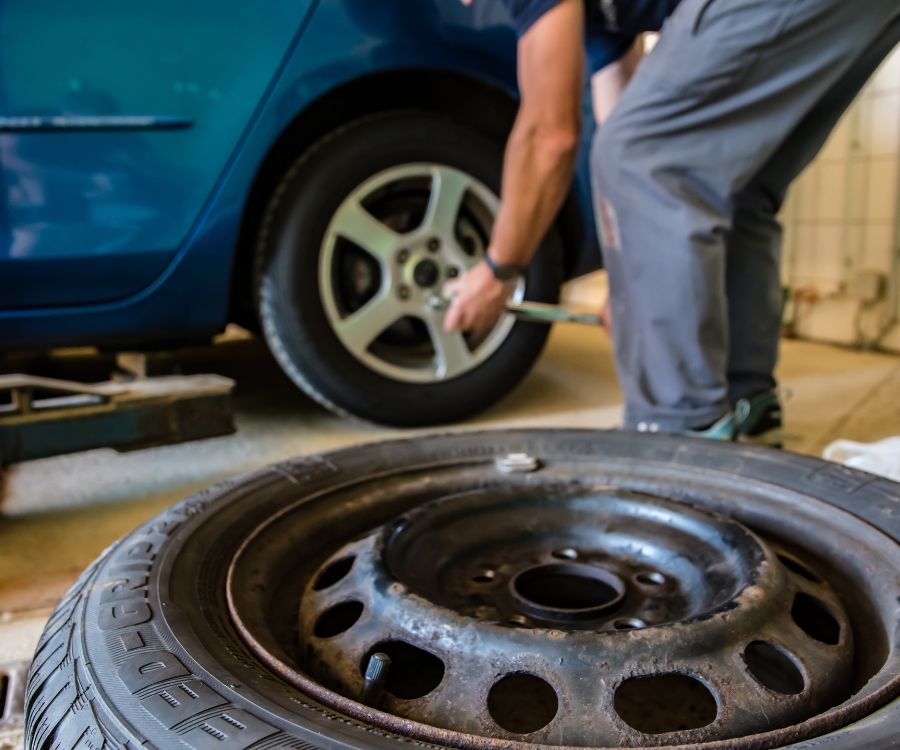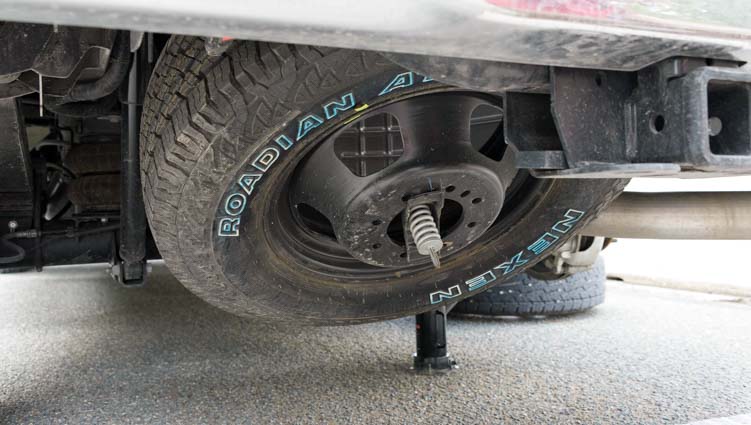Donut tires, also known as space-saver or temporary tires, are the latest evolution of spare tires. Sure, they look funny, especially on modern cars with larger wheels, but if used properly, they can be a viable solution when you have a flat tire.
Today, most modern cars come with a donut spare tire in the trunk. However, you can also purchase a spare tire yourself and free precious space in the trunk. But how will you find the perfect donut tire for your car? Let’s dig into more detail and find the best solution for you.
Donut tire is a designation used for the combination of narrow tire and smaller steel wheel. In North America, the term temporary tire also applies to the same product, while in Europe, you can find it as a space-saver tire.
These tires are designed to be used only as a spare tire, and only in case of emergencies. You shouldn’t use these tires for everyday driving, and especially if you drive on the highway. In other words, use them until you repair the damaged tire.
There are many reasons why car manufacturers utilize these tires, and it all starts with the cost. A full-size spare tire will cost much more than a donut spare tire, which can reflect on the vehicle’s sticker price. More accurately, cars with a donut spare tire will be more competitive thanks to the lower prices.
Furthermore, spare tires also free up cargo space. The difference is not significant, especially in larger cars. Nevertheless, car manufacturers can brag about a few more cubic inches of cargo space if they opt for a donut spare tire, which, again, makes them more competitive on the market.
Crucially, though, the temporary spare tire is much lighter than a regular tire and wheel combo. This means that the whole car will be lighter, which positively affects performance and fuel economy. Moreover, it lets car manufacturers keep exhaust emissions at check.
With that said, donut tires also have disadvantages. Primarily they are much worse in terms of performance and have limited traction and braking capabilities.
Donut tires last for a long time, especially if you don’t experience flat tires that often. However, if you are among the unlucky people that experience that more often, you might need to replace your donut tire after a few driving stints.
Tire manufacturers recommend driving up to 70 miles before replacing the donut tire, so it’s best not to use that distance at once. I’ve seen some people use these tires for longer, but that’s not advisable because it’s not safe.
Meanwhile, some people opt for donut tires to save space inside the trunk, or when they don’t have a viable full-size spare tire. Also, in some countries that drive on CNG or LPG, the tank for these fuels is usually installed into the spare-tire well, and a narrower donut tire is the only option.
Like regular tires, the donut models are also not created equally. Many brands offer temporary tires at various price points, which makes the purchase decision harder. Here is what you need to look out for when purchasing donut spare tires.
You should always purchase donut tires that have a similar diameter to your existing tires. And, by diameter, I mean the whole wheel – not just the rim. Otherwise, you risk damaging the stability of your car.
Fortunately, you can find many spare tire sizing charts, where you can compare the diameter of temporary spare tires with the diameter of your tire and wheel combo. Some websites will also show you only donut spare tires that fir your car, provided you enter the dimensions of your existing tires.
Or, you can also do the math on the diameter of your tires by following this detailed guide on Tire Rack.
Due to the narrower tread, but also the lower-quality tread compounds, temporary spare tires shouldn’t be used like normal tires. Simply put, these tires lack enough traction for normal driving, and they also don’t last very long, especially if used at higher speeds.
Simply put, these tires lack enough traction for normal driving, and they also don’t last very long, especially if used at higher speeds.
Each donut spare tire should only be driven at speeds up to 50 mph. Also, it would help if you were more careful in the corners, especially when it rains. Moreover, space-saver spare tires don’t last very long – they can only be used up to 70 miles.
Like with most things, there is a large price difference between various donut spare tires. Every large tire manufacturer produces temporary tires, including Bridgestone, Continental, and Pirelli. However, you can also find some budget alternatives from no-name brands.
Even though the premium and cheap donut spare tires adhere to the same limits (50mph and 70 miles), premium brands offer superior tires in terms of performance and durability. However, they are also much more expensive – temporary spare tires cost from $50 to $300. In the end, it’s your choice.
You can find donut spare tires in every single place that sells normal tires, including your nearest tire shop, but also a well-equipped gas station.
For lower prices, though, I recommend purchasing these products online. Places like Tire Rack, Discount Tire, Auto Zone offer a wide range of donut spare tires, including products from respected tire manufacturers. You can also find low-cost options on Amazon and Walmart.
I hope that this article helped you find the right donut spare tire for your car. Regardless of the brand you choose, always adhere to the limits set by the manufacturer – 50 mph and 70 miles of range.
Also, if you found this article useful, share it with your friends – it might help them the next time they purchase donut spare tires. Or, if you still scratch your head about something, please do not hesitate to ask your question in the comment section below – we’ll be happy to help!
Written by: Howmuchisit. org Staff
org Staff
Last Updated: August 8, 2018
A donut tire, also known as a spare tire to most, is meant to be a temporary replacement for a tire that has gone flat. This spare tire can be the same as the original set of tires or can be a lower, generic version. These spare tires won’t have a tread and the body of the tire won’t be reinforced, preventing it from road imperfections.
Usually, these tires can affect the car’s movement and driver’s ability to control the vehicle, and because of this, it is not recommended that you drive on a donut unless you absolutely have to. Basically, when you get a flat tire, you use the donut to get you as far as the nearest repair shop or to your home if you live close by and have a tire that can replace the flat one.
“Jacking up Scion Xb. Removing flat front” (CC BY 2.0) by mauitimeweekly
How much does a donut spare tire cost?From our research, the cost of a donut tire will depend on the car you drive and where you purchase the tire. Most tires, regardless of the car you drive, can range anywhere from $40 to $200. A factory-based donut tire that resembles the cars currently on your car will cost as much as a new tire, whereas a third-party true donut tire can cost as little as $50 to $100. These are the prices for the tire only and won’t include the professional installation at a local tire shop.
Most tires, regardless of the car you drive, can range anywhere from $40 to $200. A factory-based donut tire that resembles the cars currently on your car will cost as much as a new tire, whereas a third-party true donut tire can cost as little as $50 to $100. These are the prices for the tire only and won’t include the professional installation at a local tire shop.
The estimates mentioned above will only include the tire and no professional installation.
For instance, popular factory-based donut tires on Amazon retail for about $125 to $200.
According to TireRack.com, the price and cost of the donut tire will depend on the type and the car model. Some cars have their own specific types of tires, even if they are just for replacements. On their website, most of the spare tires range anywhere from $70 to $200.
Donut spare tire overviewYou can purchase a donut spare tire at your local dealership, tire retailer or even online at large retailers such as TireRack. com. If you don’t mind purchasing used, your local junkyard may have a selection as well. Contrary to popular belief, a donut tire isn’t universal since it needs to match the bolt pattern on your car.
com. If you don’t mind purchasing used, your local junkyard may have a selection as well. Contrary to popular belief, a donut tire isn’t universal since it needs to match the bolt pattern on your car.
The average donut tire, usually, will only last up to 70 miles. Again, remember this is a temporary solution and your car should be taken to a professional immediately to have it swapped. Check your car’s manual to see the restrictions on your car’s spare tire.
As for distance, you should also drive slower as these tires are built to withstand faster speeds. Since they are more compact, it’s best to keep your speeds under 50 miles per hour.
A donut tire is much smaller than a regular size tire, which means it is easier to fit in your trunk. Many newer cars have a place for the donut under the floor of the trunk so that it does not interfere with your storage space.
What are the extra costs?If purchased online, shipping costs may apply due to the weight of the tire.
Of course, a donut tire is a temporary solution, and you will need to budget for a brand new tire, along with installation. A new tire, depending on the brand and the car you drive, the costs can be anywhere from as little as $125 to more than $300+
When your donut tire is on, your electronic stability control and traction control systems may not work properly.
How can I save money?Weigh your options of a donut tire or a real tire. A donut tire is smaller and easier to store, but it also means you have to buy a donut and also a replacement tire in the future. If you have the room in your car, you may be able to save yourself the money and hassle of having to change the tire twice.
Aside from checking the local junkyard, other great places to find lower priced donut tires can include eBay and Craigslist. If purchasing used, pay close attention to the thread for any punctures or any sign of damage. It’s also best to make sure the tire is properly inflated before storing it.
Advertising Disclosure: This content may include referral links. Please read our disclosure policy for more info.
Average Reported Cost: $0Spare tires are useful insurance, but most are not designed to replace a flat tire indefinitely.
Not all spare wheels are created equal, and to better understand which spare tire your vehicle is equipped with, please refer to your vehicle owner's manual. Temporary spare tires generally do not have the life expectancy that regular tires do. Unlike a normal car tyre, spare tires can only have one polyester ply in the sidewall and two steel belts with a ply of polyester in the tread, meaning they can't provide half the performance and safety that an average tire can provide.
In this article we will try to describe all types of spare wheels available, and tell you how long you can drive on each of them.
These little spare tires are commonly referred to as donuts or space savers. They are very popular because they are lightweight and do not take up much space in the luggage compartment of your car. Due to the low weight, even a person who is not at all predisposed to physical activity will not find it difficult to lift and install such a spare wheel. By the way, how to do it in the field, without the help of specialists, read here.
However, because the donuts are smaller and lighter, they lack two key features of conventional tires: strength and stability. Most of these spare tires have a speed limit of up to 90 km/h. With such a spare tire, you can expect to cover a distance of 80 km, some of them can cover up to 110 km. This should be enough to find the nearest tire shop and fix the damaged tire, or find a store where you can buy a brand new tire if the previous one is no longer repairable.
From the above, we can conclude that the donut spare wheel is not recommended for long trips or pulling with its replacement with a normal, standard wheel.
Some car manufacturers fit their vehicles with full size spare tires. They are, of course, heavier than space savers and take up much more space in the trunk, but they are more durable and durable. They are able to last you much longer than donuts. However, these tires may have a different tread pattern or rubber compound than a conventional tire. This can affect overall handling and safety on the road.
Although these tires are more durable, they are primarily designed to get you to your destination before you deal with the tire problem. In addition, do not forget that the place for the spare wheel in the car is empty, and it should be filled as soon as possible before another tire is punctured.
If you do not have a spare tire in your vehicle, then your vehicle may be equipped with run-flat tires. BMW and MINI typically install these tires during production. This type of tire is tougher than other tires and can withstand a puncture and keep going. However, they are also not designed to be ridden forever.
However, they are also not designed to be ridden forever.
Most run-flat tires recommend replacing as soon as you notice a puncture. As a rule, they are designed for a distance of up to 100 km in a punctured state, then they must be replaced. Compared to regular tyres, running-flat replacements are not cheap. Some craftsmen can patch run-flat tires, but manufacturers do not recommend going down this path.
One of the advantages of these tires is that you can get to the nearest car wheel shop at speeds up to 80 km/h, i.e. almost like a breeze.
Every motorist should remember that any type of spare tire is only there to keep you moving forward and replace a punctured tire as quickly as possible. The spares are a temporary replacement, and s, while full-size spare tires may look exactly like the rest of your car, they don't have the same performance as s and can get you in trouble on the road.
Remember, your car's tires are the only thing that keeps you and your passengers on the road, so you should never speculate on your own safety or the safety of those around you.
The spare wheel, at first glance, is no different from the wheels that are installed on cars. But it turns out that not all spare wheels can be used as main wheels for a long time.
Contents
main wheels. In addition, their service life is much lower. Visually similar to the main ones, they differ in structure. The sides are made of rubber with one layer of polyester and just two bands of steel. The protector also consists of a single layer of polyester. Such tires are short-lived and quickly become unusable when driving. We will look at the two main types of spare wheels and their distinctive features.
The protector also consists of a single layer of polyester. Such tires are short-lived and quickly become unusable when driving. We will look at the two main types of spare wheels and their distinctive features.
Often, in factories, car manufacturers are equipped with spare wheels, which in our country are called "donuts" because of their small size and shape. In English-speaking countries, they are called Space Savers, which means "saving space." They fell in love with car owners because of their small size and practicality. They have advantages, but they also have disadvantages.
Donut benefits:
 Raise and install the "donut" under the force of any driver.
Raise and install the "donut" under the force of any driver.
Doughnut Disadvantages:
Some manufacturers provide full-size, durable wheels on vehicles.